四库全书英文简介
我国古代最大的一部丛书
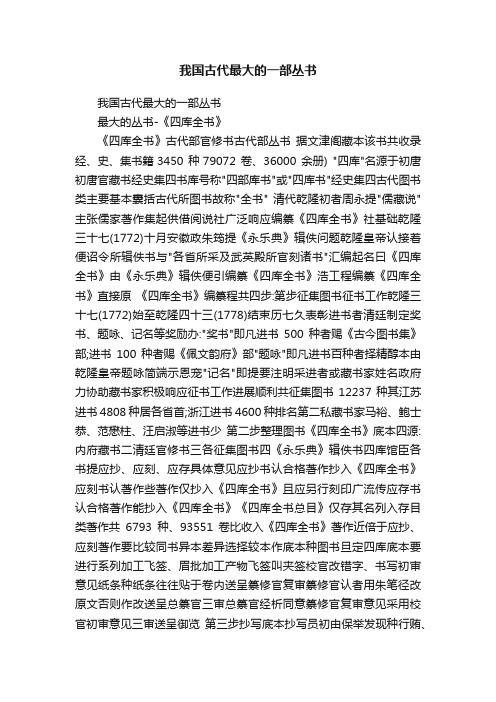
我国古代最大的一部丛书我国古代最大的一部丛书最大的丛书-《四库全书》《四库全书》古代部官修书古代部丛书据文津阁藏本该书共收录经、史、集书籍3450 种79072 卷、36000 余册) "四库"名源于初唐初唐官藏书经史集四书库号称"四部库书"或"四库书"经史集四古代图书类主要基本囊括古代所图书故称"全书" 清代乾隆初者周永提"儒藏说"主张儒家著作集起供借阅说社广泛响应编纂《四库全书》社基础乾隆三十七(1772)十月安徽政朱筠提《永乐典》辑佚问题乾隆皇帝认接着便诏令所辑佚书与"各省所采及武英殿所官刻诸书"汇编起名曰《四库全书》由《永乐典》辑佚便引编纂《四库全书》浩工程编纂《四库全书》直接原《四库全书》编纂程共四步:第步征集图书征书工作乾隆三十七(1772)始至乾隆四十三(1778)结束历七久表彰进书者清廷制定奖书、题咏、记名等奖励办:"奖书"即凡进书500种者赐《古今图书集》部;进书100种者赐《佩文韵府》部"题咏"即凡进书百种者择精醇本由乾隆皇帝题咏简端示恩宠"记名"即提要注明采进者或藏书家姓名政府力协助藏书家积极响应征书工作进展顺利共征集图书12237种其江苏进书4808种居各省首;浙江进书4600种排名第二私藏书家马裕、鲍士恭、范懋柱、汪启淑等进书少第二步整理图书《四库全书》底本四源:内府藏书二清廷官修书三各征集图书四《永乐典》辑佚书四库馆臣各书提应抄、应刻、应存具体意见应抄书认合格著作抄入《四库全书》应刻书认著作些著作仅抄入《四库全书》且应另行刻印广流传应存书认合格著作能抄入《四库全书》《四库全书总目》仅存其名列入存目类著作共6793种、93551卷比收入《四库全书》著作近倍于应抄、应刻著作要比较同书异本差异选择较本作底本种图书旦定四库底本要进行系列加工飞签、眉批加工产物飞签叫夹签校官改错字、书写初审意见纸条种纸条往往贴于卷内送呈纂修官复审纂修官认者用朱笔径改原文否则作改送呈总纂官三审总纂官经析同意纂修官复审意见采用校官初审意见三审送呈御览第三步抄写底本抄写员初由保举发现种行贿、受贿等弊病改考查办具体做:需要增加抄写员先告示应征者报名令场写字数行品其字迹端与否择优录取考查虽比保举优越便处改乡试落第徒挑选择其试卷字迹匀净者予录用先选拔3826担任抄写工作保证抄写《四库全书》需要保证进度规定抄写定额:每每抄写1000字每抄写33万字5限抄180万字五期满抄写200万字者列等;抄写165万字者列二等按照等级别授予州同、州判、县丞、主簿等四项官职发现字体工整者记罚写10000字由于措施力赏罚明所《四库全书》抄写工作进展顺利每都600事抄写工作至少抄60余万字第四步校订道关键性工序保证校订工作顺利进行四库全书馆制定《功处条例》其规定:所错字系原本讹误者免其记;原本讹确系誊录致误者每错字记;能查原本错误签请改者每处记功各册律列校订员衔名明其责书经校复校两关再经总裁抽阅装潢进呈校、复校、总裁等各司其职于保证《四库全书》质量确实起重要作用乾隆四十六(1781)十二月第部《四库全书》终于抄写完毕并装潢进呈接着用近三间抄完第二、三、四部贮文渊阁、文溯阁、文源阁、文津阁珍藏所谓"北四阁"乾隆四十七(1782)七月乾隆五十二(1787)抄三部贮江南文宗阁文汇阁文澜阁珍藏所谓"南三阁"每部《四库全书》装订36300册6752函七阁书都钤玺印文渊阁藏本册首钤"文渊阁宝"朱文印卷尾钤"乾隆御览宝"朱文印《四库全书》内容十丰富按照内容类包括4部44类66属经部包括易类、书类、诗类、礼类、春秋类、孝经类、五经总义类、四书类、乐类、类等10类其礼类周礼、仪礼、礼记、三礼总义、通礼、杂礼书6属类训诂、字书、韵书3属;史部包括史类、编类、纪事本末类、杂史类、别史类、诏令奏议类、传记类、史钞类、载记类、令类、理类、职官类、政书类、目录类、史评类等15类其诏令奏议类诏令、奏议2属传记类圣贤、名、总录、杂录、别录5属理类宫殿疏、总志、都郡县、河渠、边防、山川、古迹、杂记、游记、外记10属职官类官制、官箴2属政书类通制、典礼、邦计、军政、令、考工6属目录类经籍、金石2属;部包括儒家类、兵家类、家类、农家类、医家类、文算类、术数类、艺术类、谱录类、杂家类、类书类、说家类、释家类、道家类等14类其文算类推步、算书2属术数类数、占侯、相宅相墓、占卜、命书相书、阴阳五行、杂技术7属艺术类书画、琴谱、篆刻、杂技4属谱录类器物、食谱、草木鸟兽虫鱼3属杂家类杂、杂考、杂说、杂品、杂纂、杂编6属说家类杂事、异闻、琐语3属;集部包括楚辞、别集、总集、诗文评、词曲等5类其词曲类词集、词选、词、词谱词韵、南北曲5属除章说、戏剧著作外门类基本包括社流布各种图书著者言包括妇僧、道家、宦官、军、帝王、外等内各类物著作《四库全书》内容足:第重视儒家著作儒家著作放突位置儒家经典放四部首般儒家著作放部首第二轻视科技著作认西现代科技术"异端尤""节取其技能禁传其术"除农家、医家文算类收录少数科技著作外般科技著作收录第三收戏剧著作章说第四图书文或删节或挖改编纂《四库全书》程寓禁于征程兴文字狱程据统计达10余修书程禁毁图书3100种、15万部收入《四库全书》图书少删节或挖改编纂《四库全书》程编《四库全书荟要》、《四库全书总目》、《四库全书简明目录》、《四库全书考证》、《武英殿聚珍版丛书》等几种书看作编纂《四库全书》副产品《四库全书荟要》《四库全书》精华收书473种、19931卷本装帧形式与《四库全书》相同乾隆四十三(1778)共抄两部:部放宫御花园摛藻堂部放圆明园东墙外春园内味腴书屋《四库全书总目》二百卷《四库全书》收录书存目书总目录该目录前"凡例"经史集四部首冠总序类前序每书都著者介绍、内容提要、版本源流等考证文字由于些考证文字于纪昀、戴震、姚鼎、邵晋涵等著名者手具重要术价值《四库全书简明目录》二十卷《四库全书总目》简编本列存目书列《四库全书》收录图书每种书提要写比较简单《四库全书考证》百卷四库馆臣应抄应刻各书校勘字句记录汇编该书于校订古籍较高参考价值《武英殿聚珍版丛书》用木字印包括《四库全书》138种"应刻"书该丛书刻印4种主持金简通比较认木字花钱少实用价值高改木字印刷版金简木字印刷程写《钦定武英殿聚珍版程式》书并收入《四库全书》古代印刷史重要文献已译德文、英文等流布世界《四库全书》编纂功原何第安定社环境修书期间康乾盛世事没战争干扰四库馆臣坐书案前坐10没顾忧第二高统治者重视《四库全书》酝酿修乾隆弘历始终参预其事并由精策划征书、选择底本抄书、校书乾隆弘历都问亲自安排第三雄厚资金源《四库全书》卷帙浩繁所需经费难数计清廷概包揽第四严密组织系统四库全书馆高职务总裁副总裁由郡王士及六部尚书、侍郎兼任负责馆内切事务设纂修处缮书处监造处纂修处负责校理勘定全部书籍并兼任缮书处缮写书籍校工作;缮书处负责全书缮写及校勘事宜;监造处负责武英殿刊刻、印刷、装订、整理书籍事宜四库馆臣总计360故革职、身死除名、调用任者数第五破格录用材四库全书馆堪称才宝库集量优秀才其少破格录用邵晋涵、余集、周永、戴震、杨昌霖等入馆前仅翰林且戴震、杨昌霖等连进士都仅举才云集编纂《四库全书》创造更加利条件《四库全书》修至今已200余《四库全书》流传情况何呢七部文源阁本、文宗阁本文汇阁本已荡存文渊阁本、文津阁本、文溯阁本文澜阁本传世至今文渊阁本今藏台湾省文津阁本今藏北京图书馆文溯阁本今藏甘肃省图书馆文澜阁本战火所残阙递经补抄基本补齐今藏浙江省图书馆何评价《四库全书》虽《四库全书》编纂程删削、挖改内容等错整体言应功于首先保存量古籍古代文化总结《四库全书》编纂于弘扬民族文化于传播古代文化作重要贡献200递经战乱没集众书于身《四库全书》古籍量散失造弥补损失其古籍整理尤其辑佚、校勘、目录、汇刻丛书等面给留许益启示:辑佚面四库馆臣《永乐典》辑佚书并收入《四库全书》者共385种仅使少亡佚已久古籍珍本重见且代辑佚工作提供良范例;校勘面四库馆臣网罗众本、慎选底本等做代校勘工作树立良榜;目录面《四库全书总目》术价值古代任何官私书目与伦比其编纂世产深远影响;汇刻丛书面清《四库全书》榜掀起编刻丛书热潮近《四库全书存目丛书》《续修四库全书》版弘扬民族文化、继承发扬《四库全书》优良传统结丰硕总言《四库全书》18世纪7080代历史乃至世界历史项特型文化工程类文化史写重要页。
沈阳故宫导游词英文版
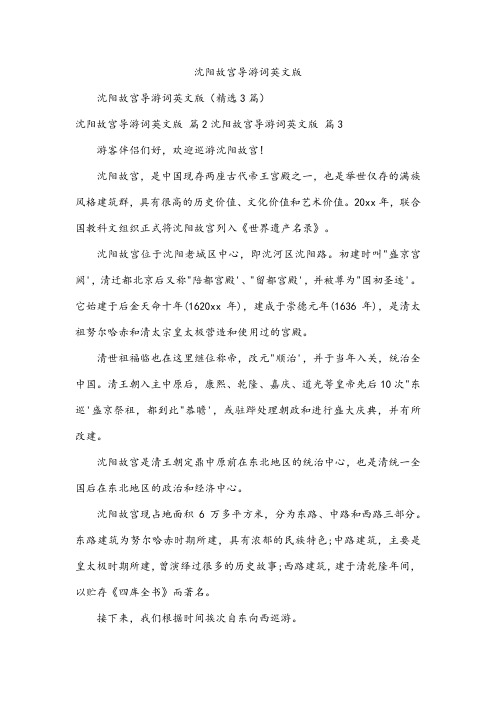
沈阳故宫导游词英文版沈阳故宫导游词英文版(精选3篇)沈阳故宫导游词英文版篇2沈阳故宫导游词英文版篇3游客伴侣们好,欢迎巡游沈阳故宫!沈阳故宫,是中国现存两座古代帝王宫殿之一,也是举世仅存的满族风格建筑群,具有很高的历史价值、文化价值和艺术价值。
20xx年,联合国教科文组织正式将沈阳故宫列入《世界遗产名录》。
沈阳故宫位于沈阳老城区中心,即沈河区沈阳路。
初建时叫"盛京宫阙',清迁都北京后又称"陪都宫殿'、"留都宫殿',并被尊为"国初圣迹'。
它始建于后金天命十年(1620xx年),建成于崇德元年(1636年),是清太祖努尔哈赤和清太宗皇太极营造和使用过的宫殿。
清世祖福临也在这里继位称帝,改元"顺治',并于当年入关,统治全中国。
清王朝入主中原后,康熙、乾隆、嘉庆、道光等皇帝先后10次"东巡'盛京祭祖,都到此"恭瞻',或驻跸处理朝政和进行盛大庆典,并有所改建。
沈阳故宫是清王朝定鼎中原前在东北地区的统治中心,也是清统一全国后在东北地区的政治和经济中心。
沈阳故宫现占地面积6万多平方米,分为东路、中路和西路三部分。
东路建筑为努尔哈赤时期所建,具有浓郁的民族特色;中路建筑,主要是皇太极时期所建,曾演绎过很多的历史故事;西路建筑,建于清乾隆年间,以贮存《四库全书》而著名。
接下来,我们根据时间挨次自东向西巡游。
一、沈阳故宫东路建筑沈阳故宫东路建筑主要包括大政殿和十王亭。
从建筑形式上看,它们都是"亭子式'建筑,似乎十一座"帐殿'依次排列在宽敞的广场中。
这种建筑形式脱胎于女真戎马生涯中的帐殿,是游牧民族"帐殿制'在皇宫建筑上的反映。
从建筑布局上看,大政殿居中,两旁分列10个亭子,从北向南,呈八字形绽开,在视觉上使大政殿更为深远,这种空间的处理方式在中国宫殿中仅此一例。
英译汉教程(第一章)
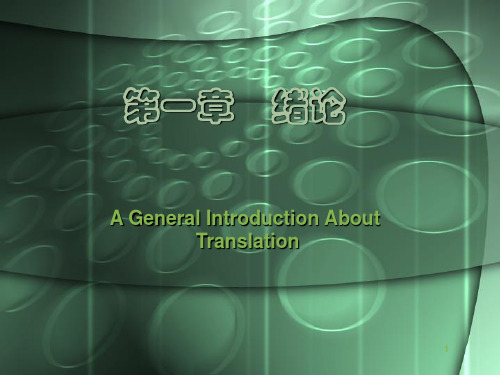
2
Classification of Translation
1) 从译出语和译入语的角度来分类: 本族语译为外语,外语译为本族语;
许渊冲贺杨振宁新婚 双语诗句
• 振宁不老松,扬帆为小翁,岁寒情更热, 花好驻春风。 • The ageless won’t grow old. You sail with your young bride. Love will warm winter cold. Spring will ever abide.
5
不懂外文的翻译家---林纾
• 林纾,字琴南,号畏庐、冷红生。生于1852年,福建闽县人。中国近代 翻译家、文学家。先后翻译英、美、法、俄、德、瑞士、比利时、西班 牙、挪威、希腊和日本小说183种,出版了160余部,其中不少是世界名 著,如《巴黎茶花女遗事》(La Dame aux Camelias)、《黑奴吁天录 》(Uncle Tom’s Cabin)《快肉余生述》(David Copperfield)、 《贼史》(Oliver Twist)、《王子复仇记》(Hamlet)等,在早期翻 译家中影响很大,是大量介绍西方文学的第一人。
第一章 绪论
A General Introduction About Translation
1
Definition of Translation
• “the replacement of textual material in one language (SL) by equivalent textual material in another language (TL).” (J.C. Catford ) • Cross-linguistic transformation of meaning
《目录学概论》教学大纲
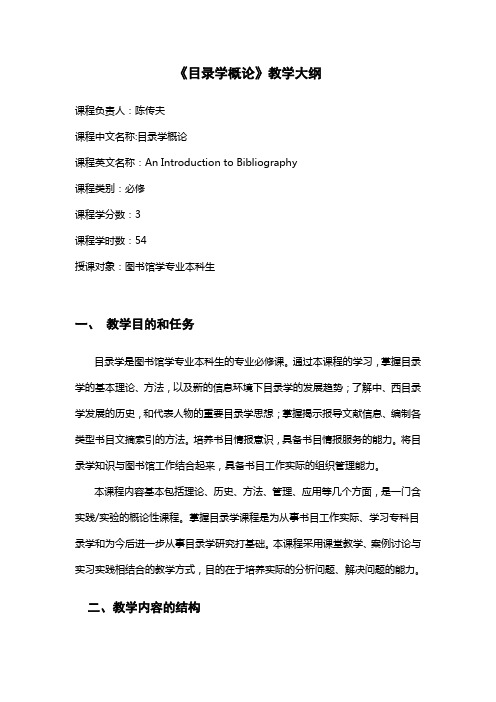
二、书目控制的经验积累
三、书目控制的深刻变革
四、UBC的产生与发展
五、UBCIM与网络环境下的书目控制
第二节书目工作的标准
一、文献著录与编目标准
二、分类标引标准
三、文献数据库标准
四、文献生产与代码标准
五、信息处理与交换标准
六、数字化信息组织标准
第三节文献范围与控制
一、微观控制
二、宏观控制
一、孔子及其文献整理
二、《七志》、《七录》、《七林》与《古今书录》
三、《郡斋读书志》、《遂初堂书目》与《直斋书录解题》
四、元明清私藏目录概述
第四节专科目录与特种目录的产生与发展
一、专科目录的产生
二、佛经的翻译传播与《汉录》
三、《综理众经目录》与《出三藏记集》
四、《大隋众经录目》等佛经目录
五、《三洞经书目录》等道藏目录
一、我国目录学研究
二、国外目录学研究
三、读者信息需求的变化与目录学
第六节目录学的理论基础与指导原则
一、关于目录学理论基础的认识过程
二、目录学理论基础的构成要素
第二章中国目录学的产生与发展
第一节官修目录的产生与发展
一、早期官方文献整理
二、《别录》与《七略》
三、从《中经》到《隋大业正御书目录》
四、《群书四部录》及其他唐代官目
五、书目整体设计与辅助索引
第二节文摘编纂法
一、文摘的特点与类型
二、文摘款目与摘要短文
三、文摘选题与文献搜集
四、文摘款目制作
五、文摘编排与辅助索引
六、各类文献的文摘
七、文摘的文体与评价
第三节索引编纂法
一、索引的理论基础
二、索引类型
我国四大文学名著书名外语翻译解趣与古代书名十二问
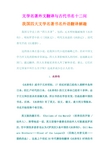
文学名著外文翻译与古代书名十二问我国四大文学名著书名外语翻译解趣我国文学史上的“四大名著”,包括:元末明初施耐庵的《水浒传》、明初罗贯中的《三国演义》、明代吴承恩的《西游记》、清代曹雪芹的《红楼梦》。
这四部古典长篇小说,是我国古代小说的巅峰之作,其对中国文学乃至文化的影响非常深远。
四大名著影响国人的同时,也逐渐走出国门。
通过翻译,四大名著被更多的人所了解和喜爱。
那么,它们在其它国家中叫什么名字呢?这或多或少会让人好奇。
1.水浒传《水浒传》成书于元末明初,17世纪时就已经传入朝鲜半岛和日本。
在江户时代的日本,《水浒传》的日文译本已经有十多种。
由于日文和汉语具有亲缘关系,所以书的名字没有变,仍是沿袭中国的书名。
后来,《水浒传》有了英文、法文、德文、意大利文等版本,书名开始变得千奇百怪。
英文版的题目有:《Outlaws of the Marsh》(沼泽里的歹徒 / 法外人),附带地说一说,英文语境中最著名的法外人可能就是罗宾汉,而中国很多读者也认为《罗宾汉》是中国的《水浒传》;《All Men are Brothers——Blood of the Leopard》(四海之内皆兄弟——猎豹的血),这是上个世纪30年代赛珍珠翻译《水浒传》时译的书名,虽然有点长,但译出了“聚义”的意思,“猎豹”点出了梁山好汉的不驯服不合作(不包括后来的接受招安),“血”则直接赋予了《水浒传》悲剧的意味——虽然很多读者不认为《水浒传》是一部悲剧;另有一个译成《Water Margin》,直译,优点当然是直白了,不过味道却不是很够。
其它文本的译名也很有意思。
在法文中,《水浒传》被译作《中国的勇士》或《沼泽地区的英雄们》,另有一个比较搞笑,居然是《一百零五个男人和三个女人在山上的故事》;德文译名则有点牵强,曰《强盗与士兵》。
另外还有一些节译本的名字则与现在的知音体差不多,如德人节译潘金莲和武大郎的章节成书,书名叫《卖大饼的武大郎和不忠实妇人的故事》,节译“智取生辰纲”则起名《强盗设置的圈套》,可谓耸人听闻。
中国特色社会文化词语英文翻译

中国特色社会文化词语英文翻译1. 元宵节:Lantern Festival2. 刺绣:embroidery3. 重阳节:Double-Ninth Festival4. 清明节:Tomb sweeping day5. 剪纸:Paper Cutting6. 书法:Calligraphy7. 对联:(Spring Festival) Couplets8. 象形文字:Pictograms/Pictographic Characters9. 人才流动:Brain Drain/Brain Flow10. 四合院:Siheyuan/Quadrangle11. 战国:Warring States12. 风水:Fengshui/Geomantic Omen13. 铁饭碗:Iron Bowl14. 函授部:The Correspondence Department15. 集体舞:Group Dance16. 黄土高原:Loess Plateau17. 红白喜事:Weddings and Funerals18. 中秋节:Mid-Autumn Day19. 结婚证:Marriage Certificate20. 儒家文化:Confucian Culture21. 附属学校:Affiliated school22. 古装片:Costume Drama23. 武打片:Chinese Swordplay Movie24. 元宵:Tangyuan/Sweet Rice Dumpling (Soup)25. 一国两制:One Country, Two Systems26. 火锅:Hot Pot27. 四人帮:Gang of Four28. 《诗经》:The Book of Songs29. 素质教育:Essential-qualities-oriented Education30. 《史记》:Historical Records/Records of the Grand Historian31. 大跃进:Great Leap Forward (Movement)32. 《西游记》:The Journey to the West33. 除夕:Chinese New Year’s Eve/Eve of the Spring Festival34. 针灸:Acupuncture35. 唐三彩:Tri-color Pottery of the Tang Dynasty/ The Tang Tri-colored pottery36. 中国特色的社会主义:Chinese-charactered Socialist/Socialist with Chinese characteristics37. 偏旁:radical38. 孟子:Mencius39. 亭/阁:Pavilion/ Attic40. 大中型国有企业:Large and Medium-sized State-owned Enterprises41. 火药:gunpowder42. 农历:Lunar Calendar43. 印/玺:Seal/Stamp44. 物质精神文明建设:The Construction of Material Civilization and Spiritual Civilization45. 京剧:Beijing Opera/Peking Opera46. 秦腔:Crying of Qin People/Qin Opera47. 太极拳:Tai Chi48. 独生子女证:The Certificate of One-child49. 天坛:Altar of Heaven in Beijing50. 小吃摊:Snack Bar/Snack Stand51. 红双喜:Double Happiness52. 政治辅导员:Political Counselor/School Counselor53. 春卷:Spring Roll(s)54. 莲藕:Lotus Root55. 追星族:Star Struck56. 故宫博物院:The Palace Museum57. 相声:Cross-talk/Comic Dialogue58. 下岗:Lay off/Laid off59. 烤鸭:Beijing Roast Duck60. 高等自学考试:Self-taught Examination of Higher Education61. 烟花爆竹:fireworks and firecracker62. 敦煌莫高窟:Mogao Caves63. 电视小品:TV Sketch/TV Skit64. XX澳门同胞:Compatriots from Hong Kong and Macao65. 文化大革命:Cultural Revolution66. 长江中下游地区:The Mid-low Reaches of Yangtze River67. 门当户对:Perfect Match/Exact Match68. 《水浒》:Water Margin/Outlaws of the Marsh69. 中外合资企业:Joint Ventures70. 文房四宝(笔墨纸砚):"The Four Treasure of the Study" "Brush/Writing Brush, Tusche/ Inkstick, Paper/ Rice Paper, and Inkstone/ Inkslab"71. 笔架:penholder72. 笔筒:brush pot73. 镇纸:paperweight74. 书法:calligraphy75. 湖笔的尖健齐圆四德:sharp,tough,neat, and round.76. 衙门 yamen77. 叩头 kowtow78. 孔子Confucius79. 牌楼 pailou;pai-loo80. 武术 wushu(Chinese Martial Arts)81. 功夫 kungfu ;kung fu82. 中庸 the way of medium (cf. Golden Means)83. 中和 harmony (zhonghe)84. 孝顺 to show filial obedience85. 孝子 dutiful son86. 家长 family head87. 宗族 patriarchal clan88. 三纲:君为臣纲,父为子纲,夫为妻纲three cardinal guides: ruler guides subject, father guides son, husband guides wife 89. 五常:仁、义、理、智、信five constant virtues: benevolence (humanity), righteousness, propriety, wisdom and fidelity90. 八股文 eight-legged essays/ eight-part essays91. 四书五经 Four Books and Five Classics92. 多子多福:The more sons/children, the more blessing/ great happiness93. 养儿防老:raising sons to support one in one’s old age94. 八卦 trigram95. 阴、阳 yin, yang96. 江湖(世界) the jianghu World(the traits’ world)97. 道 Daoism(Taoism)98. 上火 excessive internal heat99. 儒学 Confucianism100. 红学(《红楼梦》研究) redology101. 世外桃源 Shangri-la or Arcadia102. 开放 kaifang (Chinese openness to the outside world)103. 大锅饭 getting an equal share regardless of the work done 104. 不搞一刀切no imposing uniformity on …105. 合乎国情,顺乎民意 to conform with the nationalconditions and the will of the people106. 乱摊派,乱收费 imposition of arbitrary quotas and service charge107. 铁交椅iron (lifetime) post’s; guaranteed leading post 108. 脱贫 to shake off poverty; anti-poverty109. 治则兴,乱则衰 Order leads to prosperity and chaos to decline110. 锅贴 guotie (fried jiaozi)111. 花卷 steamed twisted rolls112. 套餐 set meal113. 盒饭 box lunch; Chinese take-away114. 米粉 rice noodles115. 冰糖葫芦 a stick of sugar-coated haws (or apples,etc.)116. 火锅 chafing dish117. 八宝饭 eight-treasure rice pudding118. 粉丝 glass noodles119. 豆腐脑 jellied bean curd120. 基层监督 grass-roots supervision121. 婚介所 matrimonial agency122. 机器阅卷 machine scoring123. 基础税率 base tariff level124. 婚外恋 extramarital love125. 黑心棉 shoddy cotton126. 婚纱摄影 bride photo127. 家政服务 household management service128. 即开型奖券 scratch-open ticket/lottery129. 价格听证会 public price hearings130. 集中精力把经济建设搞上去go all out for economic development131. 加强舆论监督ensure the correct orientation is maintained in public opinion132. 假帐 accounting fraud133. 叫板 challenge; pick a quarrel134. 渐进式台独 gradual Taiwan independence135.借调 temporarily transfer136. 扩大中等收入者比重Raise the proportion of the middle-income group.137. 扩大内需,刺激消费expand domestic demand and consumption 138. 焦点访谈 Topics in Focus139. 新闻调查 News Probe140. 新闻30分 News in 30 Minutes141. 市场热线 Market Hotline142. 世界经济报道 World Economic Report143. 股市分析 Stock Market Analysis144. 足球之夜 Soccer Night145. 东方时尚 Oriental Fashion146. 春节联欢晚会 Spring Festival Gala Evening147. 半边天 Half the Sky148. 综艺大观 Super Variety Show149. 戏迷园地 Garden for Opera Fans150. 大风车 Big Pinwheel151. 七巧板 Tangram152. 中华民族 Chinese Ethnic Peoples153. 周日话题 Sunday Topics154. 科技博览 Science and Technology Review 155. 人与自然 Man and Nature156. 正大综艺 Zhengda Variety Show157. 书坛画苑 Gallery of Calligraphy Painting 158. 天涯共此时 Time Together across the Strait 159. 华夏风情 China Kaleidoscope160. 中国各地 Around China161. 诗 The Book of Songs162. 书 Collection of Ancient Texts163. 礼 The Rites164. 易 The Book of Changes165. 春秋 The Spring&Autumn Annals166. 四库全书 The Four Branches of Literature167. 经部 Confucian Classics168. 史部 Historical Classics169. 子部 Philosophical&Scientific Classics 170. 集部 Literary Classics (Belles Lettres) 171. 卦 hexagrams172. 六爻 hexagram173. 卦辞 text supplementary to hexagram 174. 越剧 Yue Opera- Zhejiang&Shanghai175. 黄梅戏 Huangmei Opera- Anhui176. 豫剧 Yu Opera- Henan177. 平剧 Ping Opera- north (Hebei)178. 昆腔 Kun Tune179. 高腔 High Tune (Yi 弋 and Jing Tune) 180. 弦索腔 Xuansuo Tune181. 梆子腔 Bangzi Tune182. 皮簧腔 Pihuang Tune183. 象形字 Pictographic Characters184. 指事字 Self-Explanatory Characters185. 会意字 Associative Compounds186. 形声字 Pictophonetic Characters187. 假借字 Phonetic Characters188. 转注字 Mutually Explanatory Characters 189. 甲骨文Inscriptions on Bones&Tortoise Shells 190. 钟鼎文 Bronze Inscription191. 大篆 Big Seal Characters192. 小篆 Small Seal Characters193. 隶书 Official Script194. 楷书 Regular Script195. 草书 Cursive Hand196. 行书 Running Hand11 / 11。
圆明园历史资料英文版
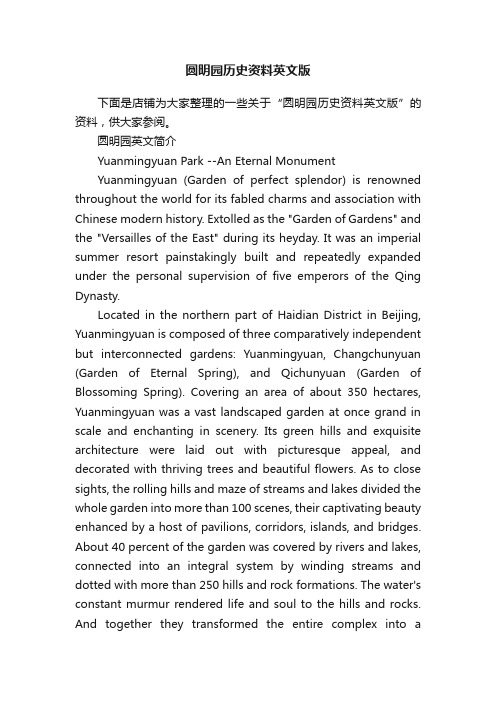
圆明园历史资料英文版下面是店铺为大家整理的一些关于“圆明园历史资料英文版”的资料,供大家参阅。
圆明园英文简介Yuanmingyuan Park --An Eternal MonumentYuanmingyuan (Garden of perfect splendor) is renowned throughout the world for its fabled charms and association with Chinese modern history. Extolled as the "Garden of Gardens" and the "Versailles of the East" during its heyday. It was an imperial summer resort painstakingly built and repeatedly expanded under the personal supervision of five emperors of the Qing Dynasty.Located in the northern part of Haidian District in Beijing, Yuanmingyuan is composed of three comparatively independent but interconnected gardens: Yuanmingyuan, Changchunyuan (Garden of Eternal Spring), and Qichunyuan (Garden of Blossoming Spring). Covering an area of about 350 hectares, Yuanmingyuan was a vast landscaped garden at once grand in scale and enchanting in scenery. Its green hills and exquisite architecture were laid out with picturesque appeal, and decorated with thriving trees and beautiful flowers. As to close sights, the rolling hills and maze of streams and lakes divided the whole garden into more than 100 scenes, their captivating beauty enhanced by a host of pavilions, corridors, islands, and bridges. About 40 percent of the garden was covered by rivers and lakes, connected into an integral system by winding streams and dotted with more than 250 hills and rock formations. The water's constant murmur rendered life and soul to the hills and rocks. And together they transformed the entire complex into alandscaping and horticultural miracle which stood comparison with the beauty of the natural scenery south of the Yangtze River.Yuanmingyuan was not only famed for its beauty. It was also an imperial museum with a vast collection of cultural treasures. The French writer Victor Hugo once remarked, "With all its treasures, Notre Dame in Paris is no match for Yuanmingyuan, that enormous and magnificent museum in the East." Furniture made of red sandalwood decorated the numerous halls in which countless rare cultural relics were on display. As one of the four most famous imperial libraries, the Wenyuan Hall (Hall of Literary Profundity) in the garden originally housed such precious ancient books as The Complete Library of Four Branches of Books (《四库全书》), Gems of the Complete Library of Four Branches of Books (《四库全书荟要》), and The Completed Collection of Graphs and Writings of Ancient and Modern Times (《古今图书集成》).Alas, the skill and sophistication of the builders of this historic "Garden of Gardens," and the cultural treasures contained within it, failed to escape the destruction inflicted on China by the Western powers. In October 1860, the Anglo-French forces sacked and looted Yuanmingyuan and burned it to the ground. From then on, the garden suffered continual damage at the hands of the warlords, bandits, and the Eight-Power Allied Forces. * Its former beauty and glory no more, the entire garden lay in clusters of ruins and debris. In hushed silence it bore witness to the atrocities of the Western powers and the corruption and incompetence of the Qing rulers, and admonished the Chinese people never to forget the tragedy.The wheels of history, however, move on inexorably. Yuanmingyuan has since undergone great changes, after thebirth of the People's Republic. The Chinese government has attached great importance to the preservation of the ruins. The district and municipal governments have placed Yuanmingyuan on a list of key cultural sites under special protection. Residential land has been requisitioned, and massive reforestation efforts have been carried out. Decades of painstaking work has turned half of the garden into green groves teeming with hundreds of thousands of trees. Most of the building foundations have been unearthed, and the remains of over a dozen scenic rock formations duly preserved. The existing carved marble masonry of the European Palaces has been pieced together to become a tourist attraction in its own right.A short journey back in history is revealing. To facilitate such a journey, the local government of Haidian District set up an administrative office for Yuanmingyuan in November 1976, which has made remarkable progress in protecting the ruins and reforesting the area. The framework of the European Palaces has been partly restored. Roads and basic facilities for the eastern half of the garden have been built and gradually improved. As a result, the number of tourists attracted to the site is increasing annually.In November 1979, the Yuanmingyuan History Exhibition Center was formally inaugurated, to the delight of visitors from at home and abroad. By 1997 the center had received more than 9.8 million visitors.On October 18, 1980, at a conference marking the 120th anniversary of the destruction of the old imperial summer palace, Soong Ching Ling, Shen Yanbing, Xi Zhongxun and over 100 other state leaders and prominent personages initiated a proposal on the preservation, restoration, and utilization ofYuanmingyuan. The Institute for the Study of Yuanmingyuan was established on the same day, thereby kindling extensive public interest in the study and preservation of this "Garden of Gardens."A garden destroyed during a nation's most traumatic years is bound to be revived in times of prosperity. In 1983 the State Council endorsed the General Plan for the Construction of Beijing. This document defined the ways and means for the development of Yuanmingyuan as a historic park. Yet, due to events in recent history, more than 2,000 mu (1 mu=1/15 hectare) of land in the park had been converted into farmland. To find a way out for the farmers, therefore, became a difficult problem. In September 1984 this problem was solved. At the suggestion of Zhang Huanwu, Du Hui, Shi Dingchao and other leaders of the Haidian District, and with the support of the Institute for the Study of Yuanmingyuan and people from all walks of life, the Administrative Office launched a project to rally the efforts of the farmers to develop the park collectively. This marked another major step for the reconstruction of Yuanmingyuan.The guiding principle for the park's development is to transform the lakes and streams and plant trees on a large scale, while accentuating the importance of the historical ruins as a prominent feature of Yuanmingyuan. Accordingly, park workers and staff members have spared no efforts to preserve the sights, reconstruct the buildings, and restore the water system, hills, and rock gardens. Their efforts made it possible for the Yuanmingyuan Park to be opened to the public on a trial basis in June 1988. In the same year, the park was designated by the State Council as a key cultural site at the national level.To highlight the characteristics of the ruins, theAdministrative Office has put them under meticulous care during the course of restoration. They have cleared certain sites, and erected description boards for the benefit of visitors. Over the past decade, they have repaired bridges, paved roads, cleared lakes, and reforested the hills. Furthermore, they have built many service facilities and purchased more than 300 pleasure-boats to ply the serene waters of the garden. Thus visitors from all over the world can now capture some of the original beauty of this summer resort, and appreciate the glamour of more than a dozen replicas of ancient buildings, under the cooling shade of glorious trees. The district and municipal authorities and the former State Education Commission also designated Yuanmingyuan as a national education base.The eastern half of the garden has gradually taken shape, where a number of scenic areas are open to tourists, such as the fuhai Scenic Area, the eastern part of Qichunyuan, and the European Palaces of Changchunyuan, which have regained their past glory with green hills and blue water enhanced by luxuriant trees and fragrant flowers, The park has also become the venue for a series of annual festivals. Including the Spring Outing Festival, the Lotus Flower Festival, and the Chrysanthemum Festival.Having been open to the public for a decade. Yuanmingyuan still has a long way to go to become a full-fledged park of historic ruins. For example, its western part is crying for development , and more funds are needed for this, as well as for many other purposes. The Administrative Office is making every effort to tackle these difficulties so that they can complete the restoration of the park in the early 21th century.The Summer PalaceThe Summer Palace is the most beautiful and the largest imperial garden in China.It was built at the beginning of the 12th century and has a history of over 800 years. It is now a world cultural heritage site.颐和园主要由万寿山和昆明湖组成,水面占全园的四分之三。
中国古代宫廷 英文

中国古代宫廷英文中国之古代宫廷,其历史源远流长,承载着深厚的文化底蕴与政治传统。
自先秦以降,历经数千年变迁,各朝代宫廷皆以其独特风貌与制度,映现了当时社会的繁荣与文明。
China's ancient imperial courts boast a rich and lengthy history, embodying profound cultural heritage and political traditions. Since the Pre-Qin era, spanning thousands of years of evolution, the courts of each dynasty have uniquely reflected the prosperity and civilization of their respective societies.II. Architecture and Layout古代宫廷建筑巍峨壮丽,布局严谨,遵循“天人合一”的哲学理念。
如紫禁城,红墙金瓦,轴线分明,彰显皇家威严。
宫殿群围绕中轴线依次展开,象征皇权至上,秩序井然。
Ancient imperial court architecture was grand and magnificent, featuring rigorous layouts adhering to the philosophical concept of "harmony between heaven and earth." The Forbidden City, for instance, with its scarlet walls and golden tiles, boasts a distinct central axis, manifesting royal authority. Palaces were arrayed symmetrically around this axis, symbolizing the supremacyof imperial power and impeccable order.III. Court Life and Rituals宫廷生活繁复而庄重,礼仪规范严密。
中国文学英文传播

中国文学英文传播由美国基督教长老会于1860年至1931年间在上海开设的美华书馆(TheAmericanPresbyteri-anMissionPress)是近代上海最重要的印刷、出版机构之一。
其刊行的几十种关于自然科学的中文书籍,在晚清“西学东渐”进程中对中国社会产生的影响已为学界所认可。
[1]同时,书馆还出版了大量中国主题的英文著述。
这些出版物使美华书馆成为继英国伦敦会的墨海书馆之后又一个中西文化交流的桥头堡。
一、美华书馆的沿革及其英文出版物概况1844年2月23日,美国长老会传教士在澳门设立“澳门美国长老会印刷所华英校书房”(MacaoPresbyterianMissionPress),次年7月迁往宁波,9月1日开业,改称“华花圣经书房”(TheChineseandAmericanHolyClassicBookEstablish-ment)。
1860年,时任书房负责人的姜别利(W.Gamble,1858-1869在任)“认识到上海作为商业中心和福音派新教会活动中心而具有重要地位”,“本能地期望事半功倍地在中国的心脏播种福音”。
[2](P177)再由于上海之于宁波还拥有购买印刷所需原材料以及向各地寄发书籍和小册子的便利,便在年底将书房迁入上海,易名美华书馆。
①随后,由于美华书馆在印刷技术上应用了姜别利的两项杰出发明———用电镀法制造汉字字模及元宝式排字架,大大提高了印刷质量和效率,迅速发展成为当时上海规模最大、最先进的活字排版、机械化印刷的印刷机构,并取代了墨海书馆成为基督教在中国最主要的出版印刷机构,在上海出版界长期居于垄断地位。
除中文出版物外,据笔者统计,美华书馆曾出版了407种英文书籍(包括修订本和重印本),②其中与中国相关者达390种之多。
这390种书籍,大致可分为4类:1.宗教及教务类,有113种,包括中英文对照的《圣经》、教会所属机构的报告、传教情况的统计及传教士的传记等,如伟烈亚力的《在华新教传教士:著作与生平》(A.Wy-lie,MemorialsofProtestantMissionariestotheChi-nese:givingalistofth eirpublications,andobituarynoticesofthedeceased,1867)。
四库全书简介

四库全书简介四库全书清乾隆1772年开始编纂,经十年编成。
中国古代最大的一部官修书,也是中国古代最大的一部丛书。
全书分经、史、子、集四部,故名四库。
据文津阁藏本,该书共收录古籍三千五百零三(3503)种、七万九千三百三十七(79337)卷、装订成三万六千余册。
保存了丰富的文献资料。
“四库”之名,源于初唐,初唐官方藏书分为经史子集四个书库,号称“四部库书”,或“四库之书”。
经史子集四分法是古代图书分类的主要方法,它基本上囊括了古代所有图书,故称“全书”。
清代乾隆初年,学者周水年提出“儒藏说”,主张把儒家著作集中在一起,供人借阅。
此说得到社会的广泛响应,这是编纂《四库全书》的社会基础。
《〈四库全书〉总目提要》又是一部重要的目录学著作。
乾隆三十七年(1772年)十一月,安徽学政朱筠提出《永乐大典》的辑佚问题,得到乾隆皇帝的认可,接着便诏令将所辑佚书与“各省所采及武英殿所有官刻诸书”,汇编在一起,名曰《四库全书》。
这样,由《永乐大典》的辑佚便引出了编纂《四库全书》的浩大工程,成为编纂《四库全书》的直接原因。
《四库全书》的编纂过程共分四步:第一步是征集图书。
征书工作从乾隆三十七年(1772年)开始,至乾隆四十三年(1778年)结束,历时七年之久。
为了表彰进书者,清廷还制定了奖书、题咏、记名等奖励办法:“奖书”即凡进书500 种以上者,赐《古今图书集成》一部;进书100种以上者,赐《佩文韵府》一部。
“题咏”,即凡进书百种以上者,择一精醇之本,由乾隆皇帝题咏简端,以示恩宠。
“记名”即在提要中注明采进者或藏书家姓名。
在地方政府的大力协助和藏书家的积极响应下,征书工作进展顺利,共征集图书12237种,其中江苏进书4808种,居各省之首;浙江进书4600种,排名第二。
私人藏书家马裕、鲍士恭、范懋柱、汪启淑等也进书不少。
第二步是整理图书。
乾隆皇帝为了存放《四库全书》效仿著名的藏书楼“天一阁”的建筑建造了南北七阁。
乾隆四十六年(1781年)十二月,第一部《四库全书》终于抄写完毕并装潢进呈。
四库全书总目

清朝官修图书目录
01 内容简介
03 特点 05 谬误
目录
02 分类索引 04 存目 06 评价
07 版本介绍
09 比较 011 编者简介
目录
08 研究 010 成因 012 英文简介
基本信息
《四库全书总目》简称《四库总目》或《四库提要》,共二百卷,是中国清代纪昀等人编纂的一部大型解题 书目,是中国古典目录学方法的集大成者。也是现有最大的一部传统目录书。
乾隆皇帝1.著录数量不同:《简目》不收存目提要,《总目》则包括“著录”与“存目“两大部分,而且 《简目》与《总目》二者著录的数量不尽相同,其差异主要表现在以下儿个方面:第一,篇目归类不同。如《皇 清职贡图》9卷,《简目》入地理类都会郡县之属,《总目》入地理类外记之属;《古今说海》142卷,《简目》 入杂家类杂编之属,《总目》入杂家类杂纂之属;第二,计卷方法不同。附卷与缺卷的计卷方法不同,是产生差 异的重要原因。第三,文字狱的影响。《四库全书总目》初步完成之后,还发生过一次在复查中撤毁库书 11种 的事件,即在乾隆五十二年(1787)发现了李清所著《诸史异同录》和周亮工所著《读画录》中有“语涉违碍” 的地方,遂将二人著作收入四库者九种,连同清代潘桂章的《国史考异》和吴其贞的《书画记》一并撤毁。上述十 一种书在迟出的《总目》中已完全不见痕迹,而在杭本《简目》中并未删除。第四,统计失误,如小学类训沽之 属,实为127卷,而《总目》误计为122卷。
3、体例撰写提要:主要包括作者简介、历代书目著录情况、成书过程、内容评述、价值评判、常见版本等。
存目存目一、四库存 Nhomakorabea的由来所谓“存目”,根据乾隆帝三十八年五月十七日上谕,就是“止存书名,汇为总目”,也即不收其书,只在 《四库全书总目》各类著录书后列“某某类存目”,给这些书留下书名、卷数并撰写提要。对照《四库全书总目 提要》,全面分析四库存目书的内容,可知存目书之所以列为存目书,其原因大致有以下四端:
外国人翻译中国名著 只能说太有才了!!
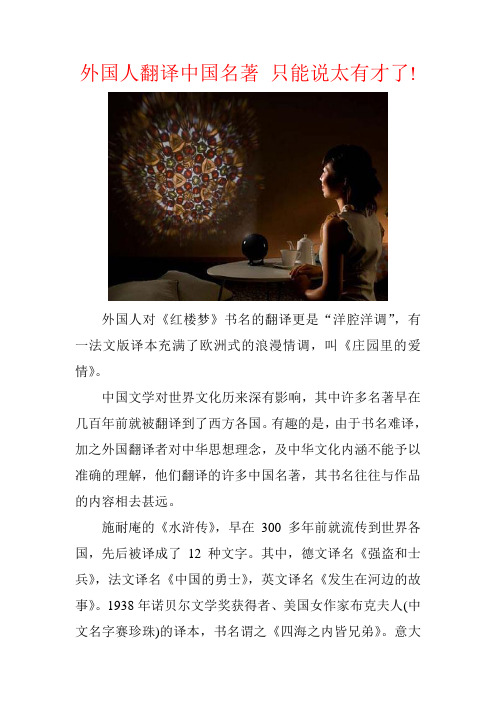
外国人翻译中国名著 只能说太有才了!外国人对《红楼梦》书名的翻译更是“洋腔洋调” ,有 一法文版译本充满了欧洲式的浪漫情调,叫《庄园里的爱 情》 。
中国文学对世界文化历来深有影响,其中许多名著早在 几百年前就被翻译到了西方各国。
有趣的是, 由于书名难译, 加之外国翻译者对中华思想理念,及中华文化内涵不能予以 准确的理解,他们翻译的许多中国名著,其书名往往与作品 的内容相去甚远。
施耐庵的《水浒传》 ,早在 300 多年前就流传到世界各 国,先后被译成了 12 种文字。
其中,德文译名《强盗和士 兵》 ,法文译名《中国的勇士》 ,英文译名《发生在河边的故 事》 。
1938 年诺贝尔文学奖获得者、美国女作家布克夫人(中 文名字赛珍珠)的译本,书名谓之《四海之内皆兄弟》 。
意大利人安德拉斯节译《水浒传》中鲁智深的故事,书名《佛节 记》 。
德国人节译杨雄的故事,取名《圣洁的爱》 ;节译武大 郎与潘金莲的故事,取名《卖大饼的武大郎和不忠实的妇 人》 ;节译智取生辰纲的故事,则取名《强盗设置的圈套》 。
如果说前面翻译的《水浒传》书名和内容多少还沾点边 的话,罗贯中《三国演义》书名的翻译,就很不可思议了。
有位美国翻译家翻译的《三国演义》 ,书名竟然叫《战神》 。
《水浒传》被翻译成多种语言。
英文版通常将《水浒传》 翻译成 Water Margin 或 Outlaws of the Marsh。
在众多译本中, 最早的当属赛珍珠女士在 1920 年代中后期翻译的 All Men Are Brothers(四海之内皆兄弟)。
书名出自 《论语》 “四海之内, 皆兄弟也”。
1933 年出版,是《水浒传》的第一个英文全译 本,当时在美国颇为畅销。
但是译本中有很多错误。
比如书 名的翻译,就不符合原意,受到过鲁迅先生的批评。
对一百 零八将的绰号,也往往望文生义,比如将病尉迟的(Yuchi) 译作"Weichi",将花和尚鲁智深译为 Priest Hwa(花牧师) , 更是将母夜叉孙二娘译为"Night Ogre"(夜间的怪物) 。
中国特色社会文化词语英文 翻译

中国特色社会文化词语英文翻译1. 元宵节: Lantern Festival2. 刺绣:embroidery3. 重阳节:Double-Ninth Festival4. 清明节:Tomb sweeping day5. 剪纸:Paper Cutting6. 书法:Calligraphy7. 对联:(Spring Festival) Couplets8. 象形文字:Pictograms/Pictographic Characters9. 人才流动:Brain Drain/Brain Flow10. 四合院:Siheyuan/Quadrangle11. 战国:Warring States12. 风水:Fengshui/Geomantic Omen13. 铁饭碗:Iron Bowl14. 函授部:The Correspondence Department15. 集体舞:Group Dance16. 黄土高原:Loess Plateau17. 红白喜事:Weddings and Funerals18. 中秋节:Mid-Autumn Day19. 结婚证:Marriage Certificate20. 儒家文化:Confucian Culture21. 附属学校:Affiliated school22. 古装片:Costume Drama23. 武打片:Chinese Swordplay Movie24. 元宵:Tangyuan/Sweet Rice Dumpling (Soup)25. 一国两制:One Country, Two Systems26. 火锅:Hot Pot27. 四人帮:Gang of Four28. 《诗经》:The Book of Songs29. 素质教育:Essential-qualities-oriented Education30. 《史记》:Historical Records/Records of the Grand Historian31. 大跃进:Great Leap Forward (Movement)32. 《西游记》:The Journey to the West33. 除夕:Chinese New Year’s Eve/Eve of the Spring Festival34. 针灸:Acupuncture35. 唐三彩:Tri-color Pottery of the Tang Dynasty/ The Tang Tri-colored pottery36. 中国特色的社会主义:Chinese-charactered Socialist/Socialist with Chinese characteristics37. 偏旁:radical38. 孟子:Mencius39. 亭/阁: Pavilion/ Attic40. 大中型国有企业:Large and Medium-sized State-owned Enterprises41. 火药:gunpowder42. 农历:Lunar Calendar43. 印/玺:Seal/Stamp44. 物质精神文明建设:The Construction of Material Civilization and Spiritual Civilization45. 京剧:Beijing Opera/Peking Opera46. 秦腔:Crying of Qin People/Qin Opera47. 太极拳:Tai Chi48. 独生子女证:The Certificate of One-child49. 天坛:Altar of Heaven in Beijing50. 小吃摊:Snack Bar/Snack Stand51. 红双喜:Double Happiness52. 政治辅导员:Political Counselor/School Counselor53. 春卷:Spring Roll(s)54. 莲藕:Lotus Root55. 追星族:Star Struck56. 故宫博物院:The Palace Museum57. 相声:Cross-talk/Comic Dialogue58. 下岗:Lay off/Laid off59. 北京烤鸭:Beijing Roast Duck60. 高等自学考试:Self-taught Examination of Higher Education61. 烟花爆竹:fireworks and firecracker62. 敦煌莫高窟:Mogao Caves63. 电视小品:TV Sketch/TV Skit64. 香港澳门同胞:Compatriots from Hong Kong and Macao65. 文化大革命:Cultural Revolution66. 长江中下游地区:The Mid-low Reaches of Yangtze River67. 门当户对:Perfect Match/Exact Match68. 《水浒》:Water Margin/Outlaws of the Marsh69. 中外合资企业:Joint Ventures70. 文房四宝(笔墨纸砚):"The Four Treasure of the Study" "Brush/Writing Brush, Tusche/ Inkstick, Paper/ Rice Paper, and Inkstone/ Inkslab"71. 笔 架:penholder72. 笔 筒:brush pot73. 镇 纸:paperweight74. 书 法:calligraphy75. 湖笔的尖健齐圆四德:sharp, tough, neat, and round.76. 衙门 yamen77. 叩头 kowtow78. 孔子Confucius79. 牌楼 pailou;pai-loo80. 武术 wushu(Chinese Martial Arts)81. 功夫 kungfu ;kung fu82. 中庸 the way of medium (cf. Golden Means)83. 中和 harmony (zhonghe)84. 孝顺 to show filial obedience85. 孝子 dutiful son86. 家长 family head87. 宗族 patriarchal clan88. 三纲:君为臣纲,父为子纲,夫为妻纲 three cardinal guides: ruler guides subject, father guides son, husband guides wife89. 五常:仁、义、理、智、信 five constant virtues: benevolence (humanity), righteousness, propriety, wisdom and fidelity90. 八股文 eight-legged essays/ eight-part essays91. 四书五经 Four Books and Five Classics92. 多子多福:The more sons/children, the more blessing/ great happiness93. 养儿防老:raising sons to support one in one’s old age94. 八卦 trigram95. 阴、阳 yin, yang96. 江湖(世界) the jianghu World(the traits’ world)97. 道 Daoism(Taoism)98. 上火 excessive internal heat99. 儒学 Confucianism100. 红学(《红楼梦》研究) redology101. 世外桃源 Shangri-la or Arcadia102. 开放 kaifang (Chinese openness to the outside world)103. 大锅饭 getting an equal share regardless of the work done 104. 不搞一刀切 no imposing uniformity on …105. 合乎国情,顺乎民意 to conform with the national conditions and the will of the people106. 乱摊派,乱收费 imposition of arbitrary quotas and service charge107. 铁交椅 iron (lifetime) post’s; guaranteed leading post 108. 脱贫 to shake off poverty; anti-poverty109. 治则兴,乱则衰 Order leads to prosperity and chaos to decline110. 锅贴 guotie (fried jiaozi)111. 花卷 steamed twisted rolls112. 套餐 set meal113. 盒饭 box lunch; Chinese take-away114. 米粉 rice noodles115. 冰糖葫芦 a stick of sugar-coated haws (or apples,etc.) 116. 火锅 chafing dish117. 八宝饭 eight-treasure rice pudding118. 粉丝 glass noodles119. 豆腐脑 jellied bean curd120. 基层监督 grass-roots supervision121. 婚介所 matrimonial agency122. 机器阅卷 machine scoring123. 基础税率 base tariff level124. 婚外恋 extramarital love125. 黑心棉 shoddy cotton126. 婚纱摄影 bride photo127. 家政服务 household management service128. 即开型奖券 scratch-open ticket/lottery129. 价格听证会 public price hearings130. 集中精力把经济建设搞上去 go all out for economic development131. 加强舆论监督 ensure the correct orientation is maintained in public opinion132. 假帐 accounting fraud133. 叫板 challenge; pick a quarrel134. 渐进式台独 gradual Taiwan independence135.借调 temporarily transfer136. 扩大中等收入者比重 Raise the proportion of the middle-income group.137. 扩大内需,刺激消费expand domestic demand and consumption 138. 焦点访谈 Topics in Focus139. 新闻调查 News Probe140. 新闻30分 News in 30 Minutes141. 市场热线 Market Hotline142. 世界经济报道 World Economic Report143. 股市分析 Stock Market Analysis144. 足球之夜 Soccer Night145. 东方时尚 Oriental Fashion146. 春节联欢晚会 Spring Festival Gala Evening 147. 半边天 Half the Sky148. 综艺大观 Super Variety Show149. 戏迷园地 Garden for Opera Fans150. 大风车 Big Pinwheel151. 七巧板 Tangram152. 中华民族 Chinese Ethnic Peoples153. 周日话题 Sunday Topics154. 科技博览 Science and Technology Review 155. 人与自然 Man and Nature156. 正大综艺 Zhengda Variety Show157. 书坛画苑 Gallery of Calligraphy Painting 158. 天涯共此时 Time Together across the Strait 159. 华夏风情 China Kaleidoscope160. 中国各地 Around China161. 诗 The Book of Songs162. 书 Collection of Ancient Texts163. 礼 The Rites164. 易 The Book of Changes165. 春秋 The Spring & Autumn Annals166. 四库全书 The Four Branches of Literature 167. 经部 Confucian Classics168. 史部 Historical Classics169. 子部 Philosophical & Scientific Classics 170. 集部 Literary Classics (Belles Lettres)171. 卦 hexagrams172. 六爻 hexagram173. 卦辞 text supplementary to hexagram174. 越剧 Yue Opera- Zhejiang & Shanghai175. 黄梅戏 Huangmei Opera- Anhui176. 豫剧 Yu Opera- Henan177. 平剧 Ping Opera- north (Hebei)178. 昆腔 Kun Tune179. 高腔 High Tune (Yi 弋 and Jing Tune)180. 弦索腔 Xuansuo Tune181. 梆子腔 Bangzi Tune182. 皮簧腔 Pihuang Tune183. 象形字 Pictographic Characters184. 指事字 Self-Explanatory Characters185. 会意字 Associative Compounds186. 形声字 Pictophonetic Characters187. 假借字 Phonetic Characters188. 转注字 Mutually Explanatory Characters189. 甲骨文Inscriptions on Bones & Tortoise Shells 190. 钟鼎文 Bronze Inscription191. 大篆 Big Seal Characters 192. 小篆 Small Seal Characters 193. 隶书 Official Script194. 楷书 Regular Script195. 草书 Cursive Hand196. 行书 Running Hand。
文渊阁四库全书安装说明
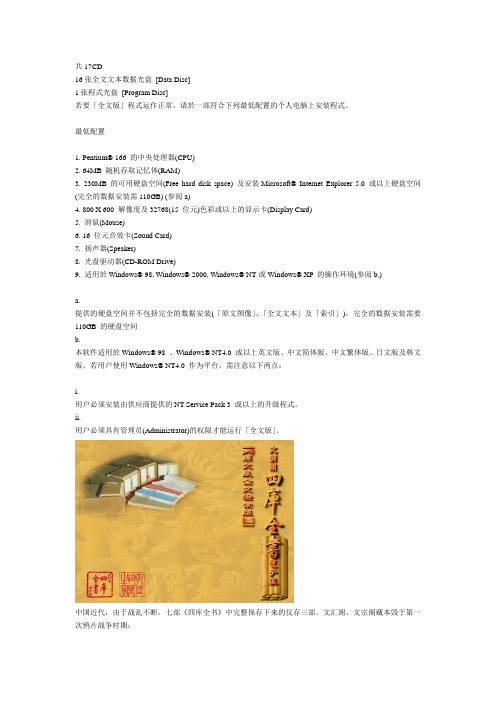
共17CD16张全文文本数据光盘[Data Disc]1张程式光盘[Program Disc]若要「全文版」程式运作正常,请於一部符合下列最低配置的个人电脑上安装程式。
最低配置1. Pentium® 166 的中央处理器(CPU)2. 64MB 随机存取记忆体(RAM)3. 230MB 的可用硬盘空间(Free hard disk space) 及安装Microsoft® Internet Explorer 5.0 或以上硬盘空间(完全的数据安装需110GB) (参阅a)4. 800 X 600 解像度及32768(15 位元)色彩或以上的显示卡(Display Card)5. 滑鼠(Mouse)6. 16 位元音效卡(Sound Card)7. 扬声器(Speaker)8. 光盘驱动器(CD-ROM Drive)9. 适用於Windows® 98, Windows® 2000, Windows® NT或Windows® XP 的操作环境(参阅b.)a.提供的硬盘空间并不包括完全的数据安装(「原文图像」、「全文文本」及「索引」),完全的数据安装需要110GB 的硬盘空间b.本软件适用於Windows® 98 、Windows® NT4.0 或以上英文版、中文简体版、中文繁体版、日文版及韩文版。
若用户使用Windows® NT4.0 作为平台,需注意以下两点:i.用户必须安装由供应商提供的NT Service Pack 3 或以上的升级程式。
ii.用户必须具有管理员(Administrator)的权限才能运行「全文版」。
中国近代,由于战乱不断,七部《四库全书》中完整保存下来的仅存三部。
文汇阁、文宗阁藏本毁于第一次鸦片战争时期;文源阁藏本被英法联军焚毁;文澜阁所藏亦多散失,后经补抄基本得全,然已非原书。
1948年,国民党政府撤离大陆,前往台湾,将故宫博物院的一些珍贵藏品运往台湾时,将《四库全书》中最为珍贵的藏本文渊阁《四库全书》带到台湾,文渊阁《四库全书》现存藏于台北故宫博物院内。
四库全书
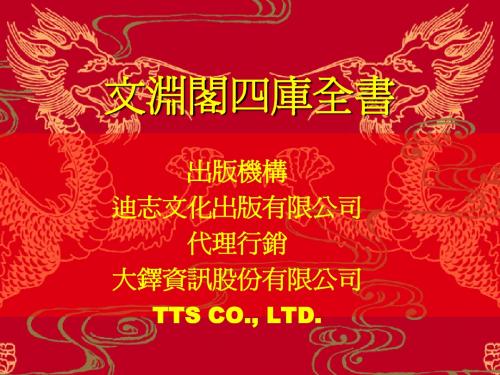
《文淵閣四庫全書》 文淵閣四庫全書》 3.0 版新增功能
採用國際編碼標準(Unicode)造字82,881 採用國際編碼標準(Unicode)造字82,881個 (Unicode)造字82,881個 字集 圖表、圖字(古字)數位化, 圖表、圖字(古字)數位化,皆可檢索 可二次檢索 部分匹配檢索 關聯字檢索 檢索, 82,881個 關聯字檢索,有82,881個漢字的關聯
選擇適合的語言程式
下載完成後, 下載完成後,執行 程式, 程式,依照步驟安 裝
登入頁面
您可以像專家一樣使用四庫全書 --[滿城盡帶黃金甲]為例 [滿城盡帶黃金甲]
滿城盡帶黃金甲的出處?? 滿城盡帶黃金甲的出處
查Google。 問專家、教授。 查紙本:四庫全書 or 其他中文參考書。
搜尋Google 搜尋
整首詩的出處: 《御定全唐詩》 作者黃巢的背景:
黄巢是冤句人。 考進士卻沒考上。 唐僖宗廣明年間作亂,攻破京都,最後沒有成 功,死於泰山狼虎谷。
檢索介面
用戶登入成功後便會進入「檢索介面」,主 用戶登入成功後便會進入「檢索介面」,主 」, 要由「全文檢索」、「類目瀏覽」 」、「類目瀏覽 要由「全文檢索」、「類目瀏覽」及「檢索 記錄」,等頁面組成。 」,等頁面組成 記錄」,等頁面組成。
春
秋
經
夏
詩、書、易、禮、 儒家、法家、兵 春秋、孝經、四 家、農家、雜家、 醫家、藝術、天 書、小學… 書、小學…等類
文算法、小說 家…等類
子
冬
史
正史、編年、傳 記、時令、政書、 別史、雜史、地 理…等類
楚辭、總集、 詞曲、別集、 詩文評… 詩文評…等類
集
文淵閣四庫全書網上3.0版 文淵閣四庫全書網上3.0版
四库提要英文
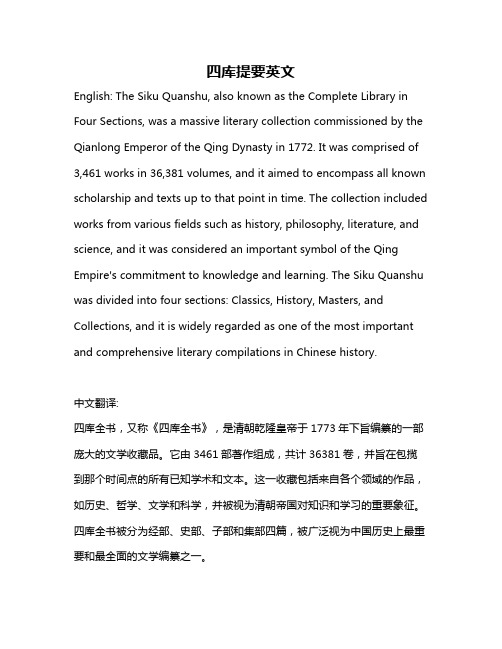
四库提要英文English: The Siku Quanshu, also known as the Complete Library in Four Sections, was a massive literary collection commissioned by the Qianlong Emperor of the Qing Dynasty in 1772. It was comprised of 3,461 works in 36,381 volumes, and it aimed to encompass all known scholarship and texts up to that point in time. The collection included works from various fields such as history, philosophy, literature, and science, and it was considered an important symbol of the Qing Empire's commitment to knowledge and learning. The Siku Quanshu was divided into four sections: Classics, History, Masters, and Collections, and it is widely regarded as one of the most important and comprehensive literary compilations in Chinese history.中文翻译:四库全书,又称《四库全书》,是清朝乾隆皇帝于1773年下旨编纂的一部庞大的文学收藏品。
它由3461部著作组成,共计36381卷,并旨在包揽到那个时间点的所有已知学术和文本。
各朝代简介及重要事件
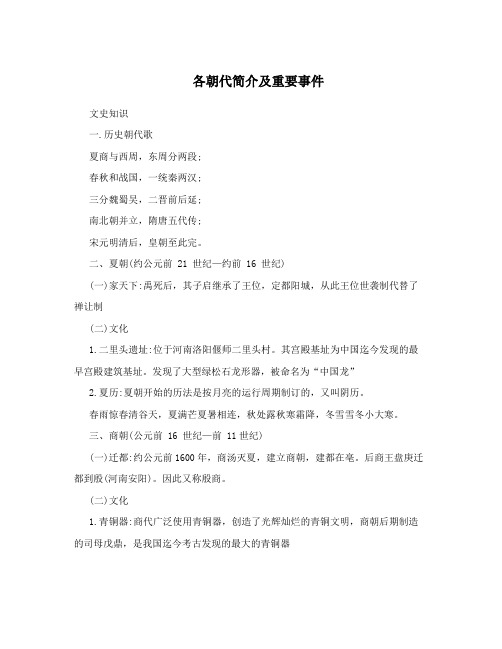
各朝代简介及重要事件文史知识一.历史朝代歌夏商与西周,东周分两段;春秋和战国,一统秦两汉;三分魏蜀吴,二晋前后延;南北朝并立,隋唐五代传;宋元明清后,皇朝至此完。
二、夏朝(约公元前 21 世纪—约前 16 世纪)(一)家天下:禹死后,其子启继承了王位,定都阳城,从此王位世袭制代替了禅让制(二)文化1.二里头遗址:位于河南洛阳偃师二里头村。
其宫殿基址为中国迄今发现的最早宫殿建筑基址。
发现了大型绿松石龙形器,被命名为“中国龙”2.夏历:夏朝开始的历法是按月亮的运行周期制订的,又叫阴历。
春雨惊春清谷天,夏满芒夏暑相连,秋处露秋寒霜降,冬雪雪冬小大寒。
三、商朝(公元前 16 世纪—前 11世纪)(一)迁都:约公元前1600年,商汤灭夏,建立商朝,建都在亳。
后商王盘庚迁都到殷(河南安阳)。
因此又称殷商。
(二)文化1.青铜器:商代广泛使用青铜器,创造了光辉灿烂的青铜文明,商朝后期制造的司母戊鼎,是我国迄今考古发现的最大的青铜器2.甲骨文:商朝的文字刻写在龟甲和兽骨上,称为“甲骨文”。
自此我国历史有文字可考。
从甲骨文发展至今日的汉字。
甲骨文之父——王懿荣四、西周(公元前11世纪—前771年)公元前1046年,武王伐纣,牧野之战击败商军,商亡。
周武王建立周朝,都城在镐,历史上称为西周。
1.西周的分封制和宗法制。
2.周厉王残暴不仁,国人忍受不了,奋起反抗,史称“国人暴动”,周厉王出逃,于是出现了“共和行政”。
共和元年(公元前841年)是我国历史有确切纪年的开始。
五、东周(公元前770-前221年)公元前771年,少数民族犬戎攻人镐京,杀死周幽王,西周灭亡。
幽王的儿子周平王继位后,将王都迁到洛邑,史称东周。
东周分为春秋(公元前770-前476年)和战国(公元前475-前221年)两个时期。
1.“春秋五霸”:齐桓公、宋襄公、晋文公、秦穆公、楚庄王。
2.老子:春秋时代的老子是道家学派的创始人,具有朴素的辩证思想,其代表作为《道德经》。
